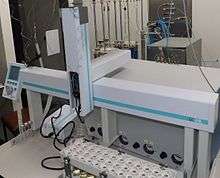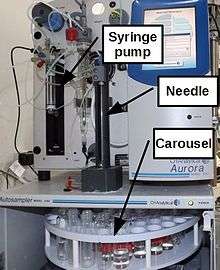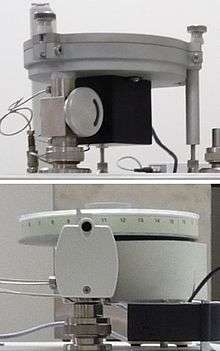Autosampler

An autosampler is commonly a device that is coupled to an analytical instrument providing samples periodically for analysis.[1] An autosampler can also be understood as a device that collects samples periodically from a large sample source, like the atmosphere or a lake, for example.
Autosamplers enable substantial gains in productivity, precision and accuracy in many analytical scenarios, and therefore are widely employed in laboratories.
Types
Autosamplers normally consist of a robotic device that can either bring the sample to a sampling station, or bring a sampling device to the sample that stays on a tray (or carousel) along with other samples.
Autosamplers for liquids

Autosamplers for liquids work along many kinds of machines that perform different kinds of chemical measurements, like titrators, gas chromatographers, liquid chromatographers, water analyzers (like total carbon analyzers, dissolved inorganic carbon analyzers, nutrient analyzers) and many others.
Many autosamplers for liquids consist of a carousel and the sampling apparatus. The carousel holds the samples, and revolves around its center so that samples change their horizontal position. There may be several concentric rings holding samples in a carousel. The sampling apparatus can be fixed horizontally, only moving up and down to allow the carousel to move, or it can also move horizontally, depending on the design of the system. The sampling apparatus in most of such autosamplers consist of a needle connected to a remote pumping syringe via tubing. Similar designs have been employed for titrators, which do not have a sampling apparatus, but a titration apparatus.
Another common design for autosamplers for liquids is of a sampling apparatus that moves freely in the 3D space, similarly to CNC routers and 3D printers, for instance. The sampling apparatus, in these autosamplers, can also be simply a needle, as for most carousel autosamplers, or it can be a compete syringe, thus dispensing the need for a remote pump. This kind of design is appropriate for small sample volumes (in the order of tens of microliters), commonly used in gas chromatography, for example.
A less common, but potentially much more affordable, kind of autosampler for liquids is a robotic arm which carries the sample to the sampling tube or needle, or to the titration area.[2]
Autosamplers for solids

Autosamplers for solids are used in conjunction with elemental analyzers. Common models consist of a carousel that holds the samples that are commonly wrapped in metal (usually tin or silver) foil. Usually, by spinning by the carousel a fixed number of degrees, a sample falls into the reactor, which is constantly purged by a carrier gas (He, for example).
There are other kinds of autosamplers for solids which use sampling boats made of ceramic, for example.
Autosamplers for gases
Autosamplers for gases can be as simple as a pump that continuously sucks air or any gas mixture inside the analytical device, or be the same as the one used for liquids, but with a gas-tight syringe.
Compatibility issues
Many autosamplers are sold as optional parts of the analytical setup, and make up for a substantial portion of its total cost. It is noteworthy that autosamplers for different devices work in a very similar way and could easily be adopted by different machines. However, this is uncommon as manufacturers often restrict the compatibility of accessories to their analytical setup.
Lack of compatibility between analytical instruments from different manufacturers has been repeatedly recognized as a problem in analytical scenarios.[3][4] A solution often proposed is the adoption of standards by different manufacturers which would enable machines to communicate between them seamless. However, there have been little real progress in this area, despite larger efforts in this direction.[4] A different solution for the lack of compatibility between analytical instruments is their coupling by means of scripting.[5][6]
References
- ↑ Cerda, Victor (1990). An Introduction to Laboratory Automation. John Wiley & Sons. ISBN 0-471-61818-7.
- ↑ Carvalho, Matheus C.; Eyre, Bradley D. (2013-12-01). "A low cost, easy to build, portable, and universal autosampler for liquids". Methods in Oceanography. 8: 23–32. doi:10.1016/j.mio.2014.06.001.
- ↑ Hawker, C. D.; Schlank, M. R. (2000-05-01). "Development of standards for laboratory automation". Clinical Chemistry. 46 (5): 746–750. ISSN 0009-9147. PMID 10794772.
- 1 2 Bär, Henning; Hochstrasser, Remo; Papenfuß, Bernd (2012-04-01). "SiLA Basic Standards for Rapid Integration in Laboratory Automation". Journal of Laboratory Automation. 17 (2): 86–95. doi:10.1177/2211068211424550. ISSN 2211-0682. PMID 22357556.
- ↑ Carvalho, Matheus C. (2013-08-01). "Integration of Analytical Instruments with Computer Scripting". Journal of Laboratory Automation. 18 (4): 328–333. doi:10.1177/2211068213476288. ISSN 2211-0682. PMID 23413273.
- ↑ Carvalho, Matheus (2017). Practical Laboratory Automation: Made Easy with AutoIt. Wiley VCH. ISBN 978-3-527-34158-0.